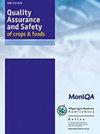The inhibitory effects of polyphenolic compounds on the damage caused by safflower fly (Acanthiophilus helianthi) in Carthamus spp.
IF 5.3
3区 农林科学
Q1 FOOD SCIENCE & TECHNOLOGY
引用次数: 2
Abstract
Seed coat color is probably a determinant factor in the antibiosis mechanism of developing resistance to safflower fly (Acanthiophilus helianthi). The purpose of this study was to determine the relationship between the phytochemical content of safflower (Carthamus spp.) seed coat extract with the seed coat color and the damage caused by safflower fly. To this end, germplasm consisting of the cultivated species (C111, with a white seed coat), the wild species (Glaucus and lanatus with a black seed coat; Azar with a brown seed coat), and a breeding line (A82 with a black seed coat) was formed. After cultivating the genotypes, the seed loss (%) and its relationship with the polyphenolic compounds and Cyanidin-3-glucoside of the seed coat extract were examined. Agricultural and phytochemical trait data were analyzed through a completely random block design. With a significant difference from other samples, a minimum damage percentage was observed in Lanatus, Glaucus, and A82 genotypes with a black coat (P < 0.05). The concentration of phenolic compounds, that is, chlorogenic acid, caffeic acid, and p-coumaric acid, except for ferulic acid, was almost equal in all genotypes. However, there was an inverse and direct relationship between the concentration of four polyphenolic compounds (rutin, apigenin, quercetin, and ferulic acid) and Cyd-3-glu content with resistance safflower fly, respectively. In general, flavonoid compounds, that is, rutin, quercetin, and apigenin, affect the resistance probably through antibiosis mechanism so that there was a negative relationship between the concentration of these compounds and resistance to safflower fly.多酚类化合物对红花蝇危害的抑制作用。
种皮颜色可能是对红花蝇(Acanthiophilushelianthi)产生抗性的抗菌机制的决定因素。本研究的目的是确定红花(Carthamus spp.)种皮提取物的植物化学成分与种皮颜色以及红花蝇对其造成的损害之间的关系。为此,形成了由栽培种(C111,具有白色种皮)、野生种(Glaucus和lanatus,具有黑色种皮;Azar,具有棕色种皮)和育种系(A82,具有黑色外皮)组成的种质。在培养基因型后,检测了种子损失(%)及其与种皮提取物中多酚类化合物和花青素-3-葡萄糖苷的关系。农业和植物化学性状数据是通过完全随机的区块设计进行分析的。与其他样品相比,具有黑色外壳的Lanatus、Glaucus和A82基因型的损伤率最低(P<0.05)。除阿魏酸外,所有基因型的酚类化合物,即绿原酸、咖啡酸和对香豆酸的浓度几乎相等。然而,四种多酚类化合物(芦丁、芹菜素、槲皮素和阿魏酸)的浓度和Cyd-3-glu含量分别与抗性红花蝇呈反比和正相关。总的来说,黄酮类化合物,即芦丁、槲皮素和芹菜素,可能通过抗菌机制影响抗性,因此这些化合物的浓度与对红花蝇的抗性之间存在负相关。
本文章由计算机程序翻译,如有差异,请以英文原文为准。
求助全文
约1分钟内获得全文
求助全文
来源期刊

Quality Assurance and Safety of Crops & Foods
FOOD SCIENCE & TECHNOLOGY-
CiteScore
4.60
自引率
7.50%
发文量
61
审稿时长
1 months
期刊介绍:
''Quality Assurance and Safety of Crops & Foods'' is an international peer-reviewed journal publishing research and review papers associated with the quality and safety of food and food sources including cereals, grains, oilseeds, fruits, root crops and animal sources. It targets both primary materials and their conversion to human foods. There is a strong focus on the development and application of new analytical tools and their potential for quality assessment, assurance, control and safety. The scope includes issues of risk assessment, traceability, authenticity, food security and socio-economic impacts. Manuscripts presenting novel data and information that are likely to significantly contribute to scientific knowledge in areas of food quality and safety will be considered.
''Quality Assurance and Safety of Crops & Foods'' provides a forum for all those working in the specialist field of food quality and safety to report on the progress and outcomes of their research.
 求助内容:
求助内容: 应助结果提醒方式:
应助结果提醒方式:


